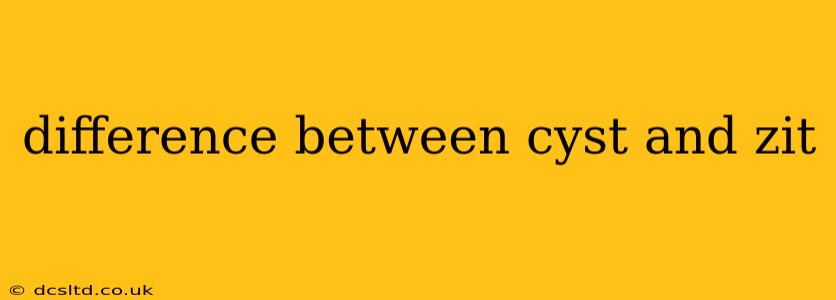While both cysts and zits (acne pimples) appear as bumps on the skin, they differ significantly in their underlying causes, characteristics, and treatment. Understanding these distinctions is crucial for appropriate self-care and seeking professional medical attention when necessary.
What is a Zit (Acne Pimple)?
A zit, more accurately known as an acne pimple, is a common skin condition resulting from clogged pores. These pores become blocked with a combination of oil (sebum), dead skin cells, and bacteria. This blockage leads to inflammation, resulting in the characteristic red, swollen, and often pus-filled bump. The severity of acne varies from mild blackheads and whiteheads to more severe cystic acne.
Types of Zits:
- Blackheads: Open comedones, where the clogged pore is exposed to air, causing the sebum to oxidize and darken.
- Whiteheads: Closed comedones, where the pore remains closed, resulting in a white bump.
- Papules: Small, raised, red bumps.
- Pustules: Papules with a pus-filled center.
- Nodules: Larger, deeper, and more painful bumps.
- Cysts: While sometimes confused, true acne cysts are a severe form of acne and differ significantly from the simple cysts described below. They are deep, painful, pus-filled lumps that can cause significant scarring.
What is a Cyst?
A cyst is a closed sac or cavity that's lined with epithelium (a type of tissue) and filled with fluid, air, or other semisolid material. Unlike zits, cysts can develop in various parts of the body, not just the skin, and are not always caused by clogged pores. They can range in size from tiny to quite large, and some can be harmless, while others require medical attention.
Types of Cysts:
Numerous types of cysts exist, categorized by their location and contents. Some common examples include:
- Sebaceous cysts: These are common skin cysts that form when a sebaceous gland (an oil-producing gland) becomes blocked.
- Epidermoid cysts: These cysts are filled with keratin (a protein found in skin and hair).
- Pilonidal cysts: These occur near the tailbone.
- Ovarian cysts: These form on the ovaries and are common in women of reproductive age.
What is the Difference Between a Cyst and a Zit?
The key differences between a cyst and a zit lie in their:
- Cause: Zits result from clogged pores, while cysts have various causes, including blocked glands, infections, or other underlying medical conditions.
- Location: Zits are primarily found on the face, back, and chest, while cysts can appear almost anywhere on the body.
- Size and Depth: Zits are generally smaller and shallower than cysts. Cysts can be significantly larger and deeper, extending beneath the skin's surface.
- Pain: While both can be painful, cysts tend to be more painful and tender to the touch than most zits.
- Appearance: Zits are typically red and inflamed, often with a visible pus-filled head, whereas cysts may appear as a larger, fluctuant (movable) lump that may or may not be inflamed.
- Treatment: Zits often respond to over-the-counter treatments or home remedies. Cysts frequently require medical intervention, such as drainage or surgical removal.
How to Treat Zits and Cysts
Zits: Treatment depends on the severity of the acne. Mild acne may respond to over-the-counter treatments like benzoyl peroxide or salicylic acid. More severe acne often requires prescription medications.
Cysts: Treatment depends on the type and location of the cyst. Some cysts may resolve on their own, while others require medical intervention, such as incision and drainage, laser treatment, or surgical removal. Never attempt to squeeze or pop a cyst at home.
Can a Zit Turn into a Cyst?
While a severe acne cyst is a type of acne, a simple zit (like a pimple or pustule) does not typically transform into a large, independent cyst. However, severe, untreated acne can lead to the development of inflammatory nodules or cystic acne, which are severe forms of acne lesions.
When to See a Doctor
Consult a dermatologist or healthcare professional if:
- You have persistent or severe acne that doesn't respond to over-the-counter treatments.
- You have a large, painful, or rapidly growing cyst.
- You have a cyst that shows signs of infection (increased redness, pain, swelling, or pus).
- You're concerned about a skin lesion's appearance.
This information is for educational purposes only and does not constitute medical advice. Always seek the advice of a qualified healthcare professional for any questions you may have regarding a medical condition.
